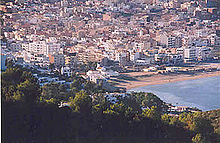M'Diq-Fnideq (prefecture)

The prefecture of M'diq-Fnideq, which is only 240 km² in size and has a population of 210,000, is part of the Moroccan region of Tangier-Tétouan-Al Hoceïma . It was only created in 2005 by separating areas of the Tétouan province . Until 2015 it belonged to the Tangier-Tétouan region .
Geography and climate
The prefecture of M'Diq-Fnideq, located on the northern slope of the Rif Mountains , encloses the Spanish exclave of Ceuta ; in the north it borders on the Strait of Gibraltar , in the east on the Mediterranean Sea , in the south on the province of Tétouan and in the west on the province of Fahs-Anjra . Apart from narrow coastal strips with beautiful sandy beaches, the hinterland is mountainous and partly forested; it reaches heights of up to about 830 m ( Jbel Musa ).
Due to the proximity to the Mediterranean Sea and the Strait of Gibraltar , the climate is comparatively cool and rainy by Moroccan standards. The summer daytime temperatures can reach up to 40 ° C, especially in sheltered locations; at night or in rainy weather, it usually cools down to around 20 ° C. Winters are frost-free and snow-free with temperatures between 10 ° C and 20 ° C.
population
Of the approximately 210,000 inhabitants of the province - many of them are Berbers who have immigrated from the Rif Mountains - around 90% live in cities and only 10% in the countryside. The language is mainly Moroccan Arabic ; the different Berber dialects of Tarifit are only spoken sporadically.
places
M'Diq , Fnideq and Martil are urban settlement areas (M); Allyene and Belyounech are considered rural communities ( communes rurales ).
| local community | 1994 residents |
2004 residents |
Residents 2014 |
|---|---|---|---|
| M'Diq (M) | 21.093 | 36,596 | 56,227 |
| Fnideq (M) | 34,486 | 53,559 | 77,436 |
| Martil (M) | 23,143 | 39,011 | 64,355 |
| Allyenes | 5,654 | 6.126 | 6,583 |
| Belyounech | - | - | 5,296 |
| to hum | 84,376 | 135.292 | 209,897 |
economy
For centuries agriculture was the livelihood of the population; fishing was also carried out on a small scale. Crafts, trade and service companies of all kinds developed in the cities. Since the 1980s, bathing tourism - mainly on the sandy beaches of Restinga-Smir - has been added as a source of income.
Reservoir
The Barrage Smir serves both the drinking water supply and the irrigation of agricultural areas.
Web links
Individual evidence
- ↑ Climate diagrams M'Diq
- ↑ Climate diagrams Fnideq
- ↑ Population statistics Morocco ( Memento from March 3, 2016 in the Internet Archive )
- ↑ Statistics Prefecture M'Diq-Fnideq

